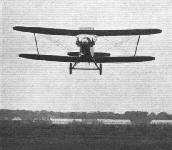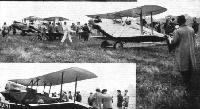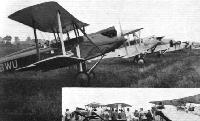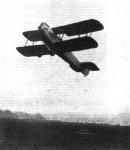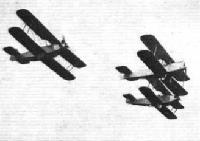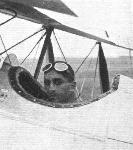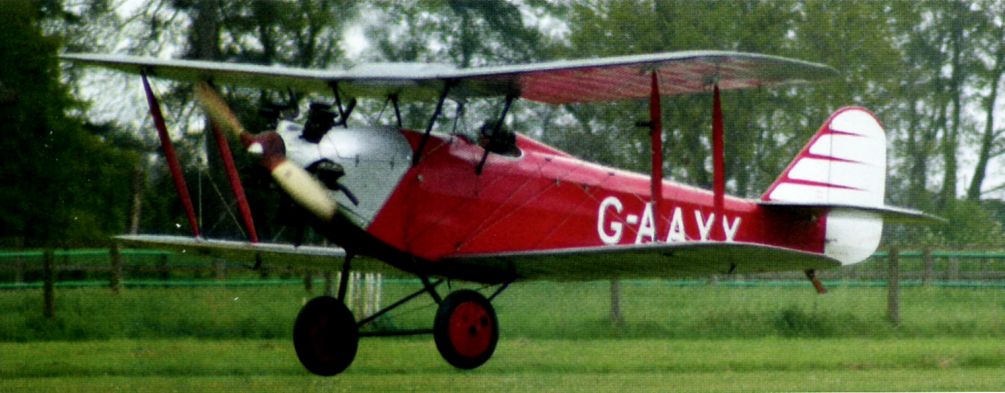
Варианты
- Avro - Baby / Type 534 - 1919 - Великобритания
- Avro - Antarctic Baby / Type 554 - 1921 - Великобритания
- Southern - Martlet - 1929 - Великобритания
Southern Martlet
Фредерик Г.Майлз после покупки двухместного Avro Baby вместе с рядом авиационных комплектующих на заводе бывшей "Avro" перегнал аэроплан в Шорехэм, Сассекс, Южная Англия. Перед перелетом Майлз установил на машине 60-сильный мотор Cirrus I, новые шасси и хвостовое оперение.
Летные данные обновленного самолета произвели положительное впечатление на "Southern Aircraft", заказавшую разработку похожего спортивного самолета. Прототип такой машины был оснащен 4-цилиндровым мотором A.B.C. Hornet в 85 л. с. и выполнил первый полет в августе 1929 года. Позже на нем установили звездообразный Genet II в 80 л. с.
За получившим наименование Southern Martlet последовали пять серийных самолетов, отличавшихся друг от друга деталями конструкции и моторами. На пяти самолетах использовалось пять разных моторов!
На самолете G-AAYZ стоял мотор Havilland Gipsy II. Его максимальная взлетная масса составляла 501 кг, размах крыла - 7,62 м, максимальная скорость - 209 км/ч.
Самолеты Martlet принимали участие в разнообразных воздушных гонках, но ни разу не добились заметного успеха. Зато Southern Martlet стал популярным демонстрационным и пилотажным самолетом.
В 1931 году был построен один Metal Martlet с каркасом фюзеляжа из стальных труб и мотором A.D.C. Hermes I мощностью 105 л. с.. Недостроенный второй Metal Martlet утилизировали.
Описание:
- Southern Martlet
- Flight, August 1929
THE "MARTLET" - Flight, April 1930
AIRCRAFT FOR THE PRIVATE OWNER - Flight, May 1931
THE METAL "MARTLET"
Фотографии
-
Мировая Авиация 240
Регистрационный номер: G-AAYX [12] Этот G-AAYX с мотором Armstrong-Siddeley Genet Major мощностью 100 л. с. в 1960 году купил в свою коллекцию фонд Шаттлуорта. После длительной и сложной реставрации аэроплан в 1988 году восстановили до летного состояния.
-
Aeroplane Monthly 2000-12 / News
Регистрационный номер: G-AAYX [12] A DOUBLE FIRST occurred at Old Warden on September 25, 2000, when Shuttleworth Collection Southern Martlet G-AAYX flew for the first time after a long restoration, and Bristol M.1C reproduction G-BWJM/“C4918", built by Northern Aeroplane Workshops, made its first ever flight.
-
Aeroplane Monthly 2000-04 / M.Oakey, T.Harmsworth - News
Регистрационный номер: G-AAYX [12] Shuttleworth’s Southern Martlet G-AAYX, now assembled, is expected to fly again this year.
-
Aeroplane Monthly 1980-07 / D.Brown - Southern Martlet /British pre-war ultralights/
Регистрационный номер: G-AAII [4] Another view of the prototype Martlet.
-
Flight 1929-08 / Flight
Регистрационный номер: G-AAII [4] -
Aeroplane Monthly 1980-07 / D.Brown - Southern Martlet /British pre-war ultralights/
Регистрационный номер: G-AAII [4] The prototype Martlet taking off from Shoreham in August 1929, powered by the 85 h.p. ABC Hornet engine.
-
Flight 1929-08 / Flight
Регистрационный номер: G-AAII [4] -
Aeroplane Monthly 1980-07 / D.Brown - Southern Martlet /British pre-war ultralights/
Регистрационный номер: G-AAVD [3] G-AAVD, the first production aircraft, powered by an 80 h.p. Genet II.
-
Flight 1931-07 / Flight
Регистрационный номер: G-AAVD [3] The Martlet ("Genet"). This is the only aircraft built private owners who want to stunt. It originates from Aircraft factory at Shoreham.
-
Aeroplane Monthly 1989-01 / Personal album. Civil
Регистрационный номер: G-AAVD [3] G-AAVD was one of two Southern Martlets entered for the 1930 King's Cup race. Flown by its designer, F. G. Miles, this Genet II-powered Martlet was forced to retire.
-
Aeroplane Monthly 1985-07 / Personal album
Регистрационный номер: G-AAYX [12] Seen at the air display held at Elstree aerodrome on July 27, 1947 is Billy Butlin's Southern Martlet G-AAYX. During the afternoon it tipped up onto its nose but was not damaged. Today it is dismantled and in the care of the Shuttleworth Collection.
-
Aviation Historian 38 / G.Peerless - Hi-de-Hi Flyers!
Регистрационный номер: G-AAYX [12] One of only six built, Southern Martlet G-AAYX (c/n 202) made its first flight in 1930, and was acquired by Billy Butlin in October 1946. While in service with Butlin’s it was painted in a colour scheme of Cambridge blue overall with cream trim including a zig-zag on the cowling. It was based at Pwllheli and used for aerobatic displays.
-
Aeroplane Monthly 1980-07 / D.Brown - Southern Martlet /British pre-war ultralights/
Регистрационный номер: G-AAYX [12] L. E. Bellairs' Martlet G-AAYX survives with the Shuttleworth Collection.
-
Aeroplane Monthly 1980-07 / D.Brown - Southern Martlet /British pre-war ultralights/
Регистрационный номер: G-AAYZ [4] Martlet G-AAYZ, built for the Rt Hon F. E. Guest and originally powered by a 120 h.p. DH Gipsy II.
-
Aeroplane Monthly 1980-07 / D.Brown - Southern Martlet /British pre-war ultralights/
Регистрационный номер: G-AAYZ [4] G-AAYZ during participation in the 1934 King's Cup.
-
Air-Britain Archive 1981-02
Регистрационный номер: G-AAYZ [4] The Gipsy II engined Southern Martlet G-AAYZ at Brooklands on 8.7.32 for the King's Cup Race in which it was flown by its owner F/O Edwards.
-
Flight 1930-11 / Flight
Регистрационный номер: G-AAYZ [4] A SINGLE-SEATER light 'plane with very fine performance. Of mixed construction. Engines fitted: A.B.C. "Hornet," Armstrong-Siddeley "Genet" and "Gipsy II."
-
Aeroplane Monthly 1980-07 / D.Brown - Southern Martlet /British pre-war ultralights/
Регистрационный номер: G-ABBN [6] Southern Martlet G-ABBN, seen at Woodford, toured with National Aviation Day Displays Ltd for the 1932 season, giving aerobatic displays.
Martlet G-ABBN was built for the Marquess of Douglas and Clydesdale, but was best known for its displays with the National Aviation Day air shows. The aircraft was scrapped in 1935. -
Aeroplane Monthly 1991-09 / Personal album. Civil
Регистрационный номер: G-ABBN [6] Southern Martlet G-ABBN flew with National Aviation Day Displays for the 1932 season and is seen here in company with Avro 504K G-ABHI and Tiger Moth G-ABUL. G-ABBN was scrapped in 1935.
Другие самолёты на фотографии: Avro Avro 504 - Великобритания - 1913De Havilland Tiger Moth / D.H.82 - Великобритания - 1931
-
Flight 1932-05 / Flight
Регистрационный номер: G-ABBN [6] AERODROME RACING: Realising the fascination of watching aeroplanes racing around a course on the aerodrome, Sir Alan Cobham has included this item in his programme. Here are seen a Southern "Martlet" and a Comper "Swift" fighting for first place.
Другие самолёты на фотографии: Comper Swift / CLA.7 - Великобритания - 1930
-
Aeroplane Monthly 1986-08 / F.Bullmore - Circus Pilot (4)
Регистрационный номер: G-ABBN [6] Ex-Imperial Airways Handley Page W.10 G-EBMR flew with Cobham s National Aviation Day Displays during 1933-34. It is seen here near Maidenhead in company with Southern Martlet G-ABBN, circa 1933.
Другие самолёты на фотографии: Handley Page H.P.18 (W.8) / H.P.30 (W.10) - Великобритания - 1919
-
Aeroplane Monthly 1976-12 / B.Williams - On tour with Cobham's Circus
Регистрационный номер: G-ABBN [6] The circus comes to yet another town. In this formation, led by H.P. W.10 G-ABMR, are two Gipsy Moths, Comper Swift, Desoutter, Tiger Moth, Airspeed Ferry and a Southern Martlet.
Другие самолёты на фотографии: Airspeed Ferry / AS.4 - Великобритания - 1932Comper Swift / CLA.7 - Великобритания - 1930De Havilland Gipsy Moth / Moth X - Великобритания - 1928De Havilland Tiger Moth / D.H.82 - Великобритания - 1931Handley Page H.P.18 (W.8) / H.P.30 (W.10) - Великобритания - 1919Koolhoven FK-41 - Нидерланды - 1928
-
Aeroplane Monthly 1986-07 / F.Bullmore - Circus Pilot (3)
Регистрационный номер: G-ABBN [6] This classic National Aviation Day display formation was probably taken in 1933, the year that Cobham purchased Handley Page W.10 G-EBMR, seen here leading Tiger Moth G-ABUL, Southern Martlet G-ABBN, D.H.60G Gipsy Moth G-ABJC and an anonymous Avro 504K. Cobham's two Handley Page W.10s were joined by Handley Page Clive G-ABYX Astra in April 1933. In two years YX carried 120,000 passengers; it was scrapped in 1935.
Другие самолёты на фотографии: Avro Avro 504 - Великобритания - 1913De Havilland Gipsy Moth / Moth X - Великобритания - 1928De Havilland Tiger Moth / D.H.82 - Великобритания - 1931Handley Page H.P.18 (W.8) / H.P.30 (W.10) - Великобритания - 1919
-
Flight 1933-07 / Flight
Регистрационный номер: G-ABIF [3] STRAINING AT THE LEASH: The line-up for the first heat of the day, at 8 a.m.
-
Flight 1933-07 / Flight
THE LIMIT MAN: Mr. T. C. Sanders getting away first in the King's Cup Race. His "Martlet" ("Genet") is a well-known sporting single seater.
-
Flight 1931-07 / Flight
SCENES AT THE START: 2 - Mr. Bramson and F./O. Leech running up the engines of their Martlets.
-
Aeroplane Monthly 1980-07 / D.Brown - Southern Martlet /British pre-war ultralights/
Регистрационный номер: G-ABIF [3] Genet-powered Southern Martlet G-ABIF owned and flown by F. G. Miles' wife before their marriage. Note the untapered ailerons.
-
Flight 1931-07 / Flight
SCENES AT THE START: 1 - Nos. 23 (Avian IV Cirrus III), 22 (Avian IV Cirrus III), 21 (Widgeon III Genet II), 28 (Martlet Genet II), 27 (Widgeon III Hermes II) lined up for the start.
Другие самолёты на фотографии: Avro Avian / Type 594/616 - Великобритания - 1926Westland Widgeon - Великобритания - 1924
-
Air-Britain Archive 1980-02
Регистрационный номер: G-AAJW [3], G-ABJW [3] Reference to the Impressment Review will show that G-AAJW was a Moth - but this clearly is not! So, what is it and why does it wear those marks?
The aircraft wearing G-AAJW is of course the Metal Martlet which should have been painted G-ABJW but having already been corrected once (it was first painted as G-AAII) it managed to retain these marks for the remainder of its short career. -
Flight 1931-05 / Flight
Регистрационный номер: G-AAJW [3], G-ABJW [3] SIDE VIEW OF THE METAL "MARTLET": In spite of the fact that the machine is a vertical biplane, the view is very good.
-
Aeroplane Monthly 1980-07 / D.Brown - Southern Martlet /British pre-war ultralights/
Регистрационный номер: G-ABJW [3], G-AAJW [3] The sole Metal Martlet bearing two different civil registrations, both incorrect. The wings were from Martlet prototype G-AAII, and the fuselage was marked G-AAJW. The correct lettering was G-ABJW!
-
Flight 1931-05 / Flight
The machine doing a "zoom."
-
Flight 1931-05 / Flight
"FORMARTING": Three of the S.A.C. "Martlets" put up some excellent formation flying at Shoreham on Saturday last, as shown on the picture. The leading machine is the metal job, with Mr. Miles up, and on the left of the picture is the "Genet-Major" model, piloted by F/O. Leech, and on the right the "Genet II" model, piloted by F/O. Thorn.
-
Flight 1931-05 / Flight
AT SHOREHAM: On the left we show old and new Shoreham, in Mr. C. L. Pashley (right) - who was associated with this aerodrome in the very early days of flying and must now be not very far short of the 10,000-hours flying mark - and Mr. F. G. Miles, Managing Director of Southern Aircraft, a more recent "settler" at Shoreham. On the right we show the Mayor and Mayoress of Worthing standing beside the Metal "Martlet."
-
Flight 1929-09 / Flight
Mr. L. E. R. Bellairs, of the Southern Aero Club and Southern Aircraft Co., in the new single-seater biplane, the "Martlet," built by the company and fitted with an A.B.C. "Hornet" engine. It has remarkable manoeuvrability, lands in an extremely short distance, and shows exceptional steadiness on the ground.
-
Air Pictorial 1955-12
Регистрационный номер: G-AAYX [12] Reader E. L. Wood has photographed the Southern Martlet, G-AAYX, at Shoreham, mentioned by Mr. J. Arnold in Letters.
-
Aeroplane Monthly 1980-10 / Skywriters
Регистрационный номер: G-AAYX [12] Sir, With regard to your feature on the Southern Martlet, I enclose two prints of Martlet ’AYX at Woodford in May 1969, when it was to be restored by someone in the Merseyside/Wirral area - I gather nothing came of it. Perhaps someone can advise of its present whereabouts and status. <...> 1 Hollythorn Avenue, G. A. JENKS
-
Aeroplane Monthly 1985-03 / Grapevine
Регистрационный номер: G-AAYX [12] The Shuttleworth Collection's Southern Martlet, G-AAYX, seen propped together, awaits a sponsor for its restoration.
-
Aeroplane Monthly 1996-05 / M.Oakey - Vintage news
Регистрационный номер: G-AAYX [12] After seven years' restoration work on a “when time permits" basis at Old Warden, the Shuttleworth Collection’s Southern Martlet G-AAYX has just been fully assembled for the first time. With the airshow season about to begin, however, the project will again be suspended until next winter. Owned at one time by holiday-camp tycoon Billy Butlin, the aircraft last flew in 1949.
-
Aeroplane Monthly 1998-12 / M.Oakey, T.Harmsworth - News
Регистрационный номер: G-AAYX [12] Shuttleworth Collection Southern Martlet G-AAYX, which is nearing completion of a long-term restoration to airworthiness in the collection’s Old Warden workshops, now has its controls connected up, and the ailerons have been waggled for the first time in many years. This picture of the uncovered airframe was taken on October 4, 1998; fabric covering of the tail started on October 17, with the ailerons to follow next.
-
Aeroplane Monthly 1980-07 / D.Brown - Southern Martlet /British pre-war ultralights/
Southern Martlet; Metal Martlet
- Фотографии






